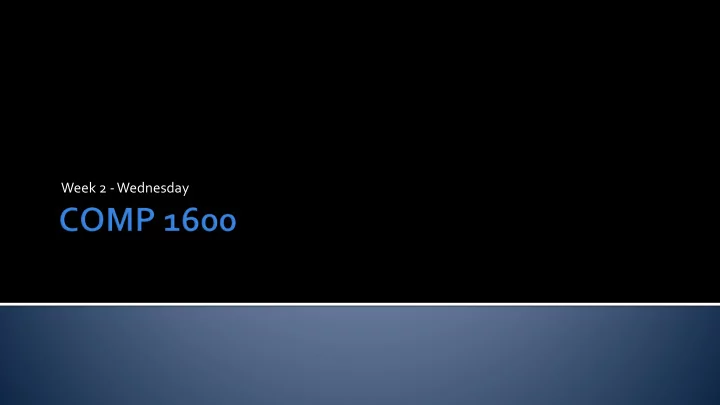

Week 2 -Wednesday
What did we talk about last time? Types int boolean double char String Basic input
Rules for variables: They must start with a lowercase letter, an uppercase letter, or an underscore After that, you can have as many letters, digits, and underscores as you want No spaces in variable names! Regular variables should be in lowercase The camel case convention says that new words start with an uppercase letter: ▪ elegantBalloons ▪ aReallyLongUselessVariableName Constants should be in ALL CAPS Then, underscores are used to separate the words: ▪ GRAVITATIONAL_CONSTANT
There are three parts to using Scanner for input Include the appropriate import statement so that your program 1. knows what a Scanner object is 2. Create a specific Scanner object with a name you choose Use the object you create to read in data 3.
Scanner has a lot of methods (ways to accomplish some tasks) For now, we're only interested in three These allow us to read the next int , the next double , and the next String , respectively: Scanner in = new Scanner(System.in); int number = in.nextInt(); double radius = in.nextDouble(); String word = in.next();
import java.util.Scanner; public class Age { public static void main(String[] args) { Scanner in = new Scanner(System.in); System.out.println("What is your age?"); int years = in.nextInt(); years = years * 2; System.out.print("Your age doubled is "); System.out.println(years); } }
In Java , each data type has a set of basic operations you are allowed to perform It's not possible to define new operations or change how the operations behave Some programming languages allow this, but not Java
Today, we are going to consider the basic operations for numerical types: int double
Use the + operator to add two int s together int a; int b; a = 5 + 6; // a contains 11 b = a + 3; // b contains 14 a + b; // not allowed, does nothing a = a + 1; // a contains 12, and b?
Some expressions are used so often, Java gives us a short cut x = x + y; can be written x += y; x = x + 1; can be written x++; or ++x; int x; x = 6; // x contains 6 x += 4; // x contains 10 x++; // x contains 11 ++x; // x contains 12
Exactly like + except performs subtraction int a; int b; a = 5 - 6; // a contains -1 b = 3 - a; // b contains 4 a -= 10; // shortcut for a = a – 10; a--; // shortcut for a = a – 1;
The * operator performs multiplication int a; int b; a = 5 * 6; // a contains 30 b = a * 3; // b contains 90 a *= 2; // shortcut for a = a * 2;
The / operator performs integer division Not the same as regular division int a; int b; a = 3; // a contains 3 b = a / 2; // b contains 1 a /= 2; // shortcut for a = a / 2; The factional part is dropped, not rounded
The % operator is the mod operator It finds the remainder after division int a; int b; a = 8; // a contains 8 b = a % 5; // b contains 3 a %= 2; // shortcut for a = a % 2; This operator is a good way to find out if a number is even or odd
Exactly the same as + for int , except now you can have fractional parts double a; double b; a = 3.14159; // a contains 3.14159 b = a + 2.1; // b contains 5.24159 a += 1.6; // shortcut for a = a + 1.6; a++; // shortcut for a = a + 1.0;
No surprises here They do subtraction and multiplication double a; double b; a = 3.14159; // a contains 3.14159 b = a - 2.1; // b contains 1.04159 a = b * 0.5; // a contains 0.520795
Unlike int , this division does have fractional parts double a; double b; a = 3; // a contains 3.0 b = a / 2; // b contains 1.5 b = 3 / 2; // b contains 1.0 Can you explain this mystery?
Yes, there is a % operator for double , but it is rarely used Don't worry about it for now
Given a temperature in Celsius, what is the equivalent in Fahrenheit? T F = (9/5)T C + 32
How complex can expressions get? int a = 31; int b = 16; int c = 1; int d = 2; a = b + c * d – a / b / d; What's the value of a ? 18!
Order of operations holds like in math int a = 31; int b = 16; int c = 1; int d = 2; a = (((b + c) * d) – a / b) / d; You can use parentheses to clarify or change the precedence Now a is 16
You cannot directly store a double value into an int variable int a = 2.6; // fails! However, you can cast the double value to convert it into an int int a = (int)2.6;// succeeds! (a = 2) Casting tells the compiler that you want the loss of precision to happen You can always store an int into a double
Practice using mathematical operations Operations on boolean and char values
Keep reading Chapter 3 of the textbook Get a start on Project 1 Lab 2 is tomorrow for second half of the class, alphabetically
Recommend
More recommend